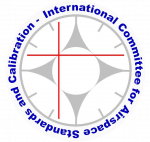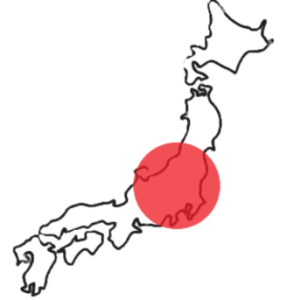France
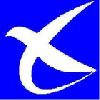 Flight inspection history in France, started in 1948. At that time, S.T.S (Service des Transmissions et de la Signalisation) was in charge of the {{ Navaids }} inherited from World War II. In fact, four or five landing systems and as many navigation systems. G.A. (Groupement Aérien) was responsible for the {{ laboratory aircraft }}.
Flight inspection history in France, started in 1948. At that time, S.T.S (Service des Transmissions et de la Signalisation) was in charge of the {{ Navaids }} inherited from World War II. In fact, four or five landing systems and as many navigation systems. G.A. (Groupement Aérien) was responsible for the {{ laboratory aircraft }}.
The fleet was composed of a Junker JU 52 (F-BBYF), a Nord N 1100 (F-BBJO), used for in-flight experiments, a Douglas DC 3 for transportation, and a Siebel NC 701 (F-BBFS).
The offices were located in Paris and the laboratory and aircraft were based at Le Bourget airport in the famous {{Hangar 10 }}which still exists.
At the beginning of the 50’s, S.T.S became S.T.N.A (Service Technique de la Navigation Aérienne), and G.A was changed to S.F.A (Service de la Formation Aéronautique). Nowadays, these two services are still in charge of flight inspection, the former for technical aspects, and the latter for aircraft management.
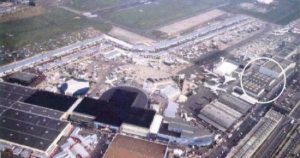 Airal view of Le Bourget Air Show, Hangar 10 is indicated with a white circle
Airal view of Le Bourget Air Show, Hangar 10 is indicated with a white circle
In 1950, the JU 52 was replaced by a SNCASO SO 95 (F-BBIE) which was, in fact, the first real laboratory aircraft. In 1954, a new Douglas DC 3 (F-BEIF) was added to the fleet.
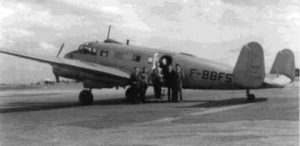 The Siebel NC 701
The Siebel NC 701
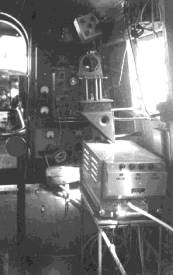 Inside the Siebel NC 701, an experimental DME Bench
Inside the Siebel NC 701, an experimental DME Bench
These aircraft participated in Consol, Loran and Decca systems experiments, as well as flight inspection of the first VORs and ILSs.
The reference trajectography was provided by a manual theodolite.
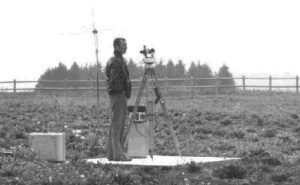 Manual Theodolite…and skilled operator
Manual Theodolite…and skilled operator
The measurements were performed on an analog bench with paper chart and ink recorders.
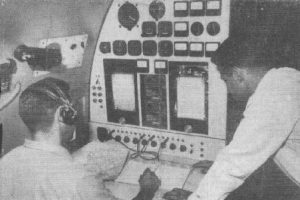 The F-BEIF Analog Bench
The F-BEIF Analog Bench
Before the French Air Force performs its own flight inspection for military ILSs, this task was assumed by STNA.
In 1960, flight inspection moved to C.E.N.A. (Centre d’Expérimentation de la Navigation Aérienne) located at Orly airport, meanwhile offices and laboratory remained in Paris and the fleet at Le Bourget.
In 1962, another DC 3 (F-BFGX) came to reinforce the unit and in 1964 the F-BEIG (also a DC 3), replaced the ageing F-BEIF.
 DC 3 F-BEIF in Africa….
DC 3 F-BEIF in Africa….
It became necessary to add new aircraft to the fleet because of the increasing flight inspection workload in Africa, especially in the former French colonies of the northern and western parts of the continent. Also, at the same period, flight inspection at Berlin airport became a routine activity.
In 1968 the offices and laboratory moved to Orly Airport, but the aircraft remained at Le Bourget. At the end of the 60’s, flights were still increasing due to the greater number of facilities and also to geographical expansion: 1964 to 1969 : Yugoslavia, Middle East and Indian Ocean, French West Indies, French Guyana, Algeria.
For this purpose, in 1966, a Lockheed Constellation L 1049 (F-BAZT), whose first mission was SAR (Search And Rescue) activities, was used for long range missions in French West Indies and Guyana. A portable bench installed in a military DC 6, was used for flight inspection in Polynesia.
In 1969, the fleet was reduced. The unit kept only the two old DC 3s and received two Dassault Mystère 20 (F-BMKK and F-BNRH) (known as Falcon 20). The first one was used for long range missions in Syria, Iraq, Egypt and French West Indies, and the second one to perform high altitude multiVOR flight inspection.
The three former aircraft were equipped with the very new bench known as « 19.42 », (Home made design), still using analog technology, and the latter with the S.A.V.V.A.N system (Système Automatique de Vérification en Vol des Aides à la Navigation).
The S.A.V.V.A.N system, developed by THOMSON, was the first flight inspection system whose masterpiece was a computer (SN 1050) equipped with the first digital VOR receiver (CDC).
The concept of High Altitude MultiVOR flight inspection already existed in the USA (SAFI system: Semi Automatic Flight Inspection system). The method consists in performing several flights along a type of grid. During these flights, several VORs can be received at once and checked. Assuming that each VOR is surrounded by different legs of the flights, when the grid has been completed, each VOR has been inspected across its 360°.
This method, which is still in use, is very economical. (About half flight hour for each VOR inspected instead of one hour and half.)
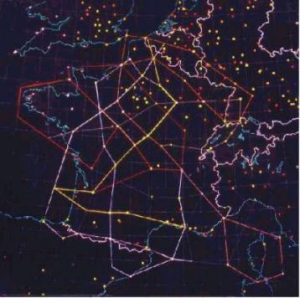 SAVVAN Flight Grid for the Mystère 20 F-BNRH
SAVVAN Flight Grid for the Mystère 20 F-BNRH
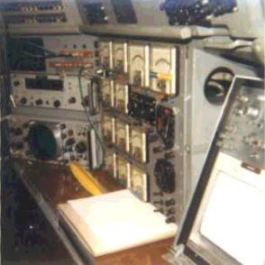 F-BMKK Bench
F-BMKK Bench
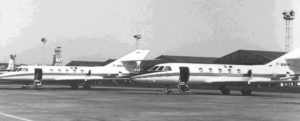 70’s Aircraft….Mystère 20 F-BMKK and F-BNRH
70’s Aircraft….Mystère 20 F-BMKK and F-BNRH
In 1973/1974, the ageing DC 3s were retired after many years of good service. At the same time, the Mystère 20s were also removed from the flight inspection unit, because of their high consumption during low altitude runs.
These aircraft were replaced by two Nord N 262 (F-BOHH and F-BSUF) for low altitude VOR / ILS flight inspection, and an SE 210 « Caravelle » (F-BJTI) for high altitude VOR flight inspection (SAVVAN system).
The Caravelle, which kept its Air France livery, was also used by E.N.A.C (Ecole Nationale de l’Aviation Civile : national civil aviation school), as a flying classroom for air traffic controllers, technicians and engineers.
The SAVVAN grid was completed with a few additional legs, to allow the Caravelle to perform VOR flight inspection in Belgium, Luxembourg and Switzerland at the same time as in France.
The two N 262 were equipped with the « 19.42 » bench as the DC 3s were.
The new feature came from the replacement of the manual thedolite by an infrared automatic tracker, the MINILIR developed by SAT.
(Accuracy 5/1000 Deg, range 10 Nm, depending on the visibility)
The infrared source was provided by a servoed light fitted between the two main landing gears, always aiming towards the tracker at the ground.
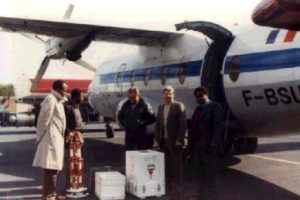 Nord N 262 F-BSUF
Nord N 262 F-BSUF
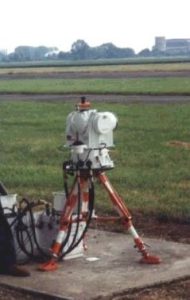 Minilir infrared Tracker
Minilir infrared Tracker
During these years, another device, the TRIDENT system built by THOMSON, was added to the Minilir. This equipment provided an accurate distance measurement.(1.5 m).
For the first time, three-dimensional trajectography was possible, (Rho, Teta and Phi), paving the way to the automatic computerised flight inspection benches.
In 1973, The Flight Inspection Division returned from CENA to STNA, and the offices, laboratory and aircraft were planned to move to Melun-Villaroche airport.
This moving was completed in 1976, and for the first time, all the components of the unit were located in the same place.
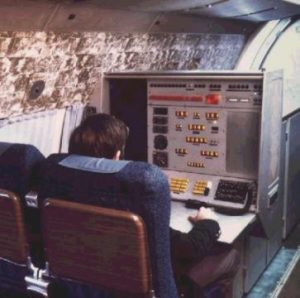 The S.A.V.V.A.N system in the Caravelle
The S.A.V.V.A.N system in the Caravelle
Due to the increasing workload in France, (more and more VORs and ILSs to check), the activity in foreign countries was significantly reduced.
In order to improve efficiency and productivity, studies were launched towards new methods of fixing the aircraft position, and new computerised benches. A new trajectography system based on the updating of a INS (LTN 51) with an optoelectronic device, during the overfly of the runway, through three points (parabolic error model), was developed and experimented by STNA between 1979 and 1985. The prototype was successful, but was abandoned for operational reasons.(no results in real time, only after a short delay, complexity of the system, etc.)
The new computerised bench was developed between 1982 and 1987 by STNA jointly with SFIM. This system, called SMCV, (Système Multifonction de Contrôle en Vol) was able to replace the SAVVAN system, and to check mainly ILSs, VORs, and MLSs. It became operational in 1985 / 1986 for the first functions.
For cost considerations, the flying classroom in the Caravelle was abandoned by ENAC, and the flight inspection activity alone could not justify such an aircraft. So in 1986, it was retired from the fleet, and the SAVVAN multiVOR flight inspection was performed by SMCV on board the N262 F-BSUF.
The fleet, reduced to the two N 262, was efficient enough to cover national activity. A mobile bench was constituted with spare equipment from the SMCVs. This bench was sent abroad periodically and installed in local aircraft specially modified to receive it, to perform flight inspection in overseas French territories.
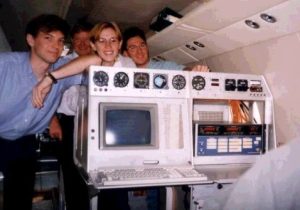 SMCV system in the N262 F-BOHH
SMCV system in the N262 F-BOHH
This situation remained unchanged until 1992, when the oldest N 262 (F-BSUF) was retired and replaced by an ATR 42 (F-GFJH). Four years later, the second N 262 (F-BOHH) was retired and replaced by a Beechcraft BE 200 (F-GJFA). The ATR 42 was equipped with the SMCV system from the N 262 and the BE 200 was equipped with the brand new light flight inspection system CARNAC 21 developed by SFIM according to STNA specifications.
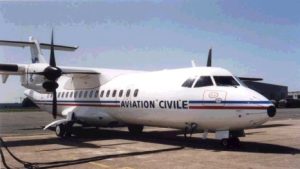 ATR 42 F-GFJH
ATR 42 F-GFJH
This great change had been initiated in 1988 with an STNA study, aiming to replace the full optical fixing position device with a standard D-GPS/INS hybrid system, the last portion of the approaches being covered by the infrared tracker. After trials and some years of improvements, the fast advances of the technology favoured of another system, the VP-DGPS (VP for Very Precise), based on dual frequency carrier phase tracking GPS receivers. This technique allowed a proved accuracy to be reached of ten centimetres in aircraft fixing position. Since 1995, the system has been used operationally for flight inspection of all navaids, including ILS Cat III and MLS. It is the first time that a full D-GPS reference system is used alone for such flight inspections.
Since the mid 90’s, the new technologies in computers and other equipment, has allowed the size and the weight of the flight inspection systems to be significantly reduced. This is the reason why the new CARNAC 21, associated with the light D-GPS portable ground station, could be installed in the BE 200.
A second light bench CARNAC 21 is also sent abroad periodically and installed in local BE 200s specially modified to receive it, to perform flight inspection in overseas French territories : Polynesia, New Caledonia, St Pierre et Miquelon Islands. Some others such as French West Indies, Guyana and La Réunion Island are subcontracted to ASECNA based in Dakar, Senegal. A third light bench CARNAC 21 is planned to be installed (for 2001), in the ATR 42 to replace the last ageing SMCV system. The latest great change in the Flight Inspection Division life, came in 1998 when all the various services of STNA located in the Paris region, moved to Toulouse to one single site. The Flight Inspection Division offices and laboratory are in the main building, and the aircraft are based at Blagnac airport. Today, with a fleet of modern and economical aircraft, equipped with the most up-to-date flight inspection systems, STNA can envisage its tasks with serenity. STNA carries out flight checks of approximately 100 ILSs, 100 VORs mainly and all other type of navaids (DME, MLS, VHF/COMM, Gonio, PAPI/VASI, RADAR). With its specialists and its equipment, STNA is ready for the future when GNNS enters flight inspection duty.
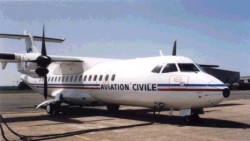 BE 200 F-GJFA
BE 200 F-GJFA
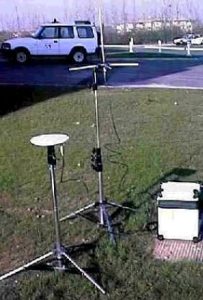 VP-DGPS portable ground station
VP-DGPS portable ground station
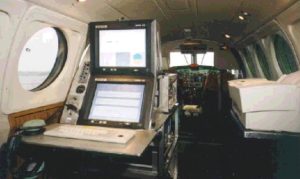 CARNAC 21 new generation Flight Inspection System in the BE 200 F-GJFA
CARNAC 21 new generation Flight Inspection System in the BE 200 F-GJFA
Bibliography:
Escales de notre temps, ou l’aventure du contrôle en vol Georges CORON, 1986
Photos:
Newspapers, STNA, EUROCONTROL, Georges CORON, Jacques-Paul DAVADANT
Update:
March 2000
